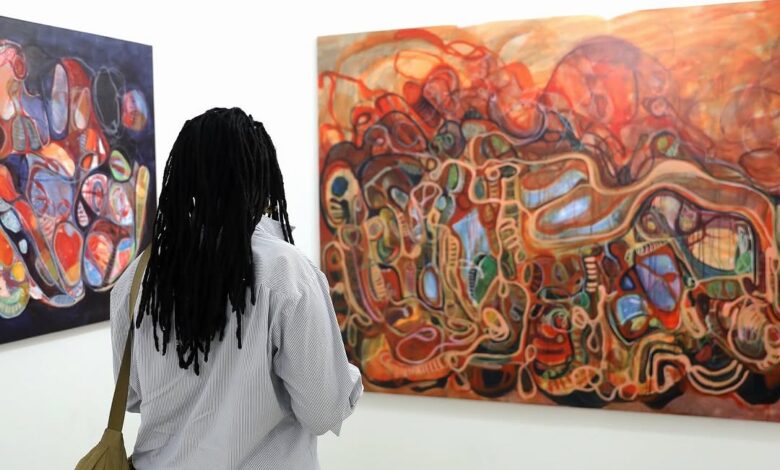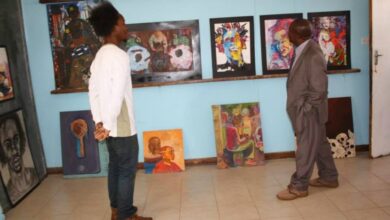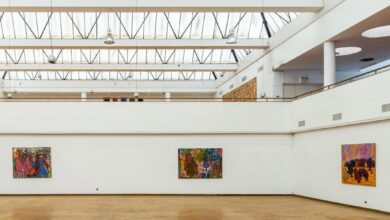Shamilla Aasha’s “For Those Who Have Gone Before Me”: A Bold and Evocative Solo Exhibition at FFG Harare

Shamilla Aasha, a visual artist hailing from Hwange and based in Bulawayo, recently made a striking debut at First Floor Gallery (FFG) Harare with her solo exhibition For Those Who Have Gone Before Me. This exhibition marked a significant milestone in Aasha’s career, as it was her first solo showcase of paintings, highlighting a rare moment for an artist from her region to take center stage in Zimbabwe’s capital city.
Aasha’s art journey has seen her regularly participating in group exhibitions across the country, developing her unique voice in the process. This solo exhibition, however, brought a new level of depth and complexity to her practice. Aasha’s ability to fluidly transition between mediums—moving from a previous three-dimensional project involving textiles to now working with acrylic and oil paint on canvas—demonstrates her versatility and commitment to artistic exploration.
The works in For Those Who Have Gone Before Me include a series of 13 paintings titled Unleashed, along with a piece titled A Step in Time, and the largest work that gives the exhibition its title. These paintings explore the artist’s journey of reclaiming her mark, a theme she felt she had lost during a year and a half of absence from the art scene. Aasha describes this time as one of self-reflection, where she focused on the authenticity of her mark-making.
The title Unleashed evokes a powerful sense of freedom, perhaps referencing a release from constraints, much like an unleashed animal or a momentous, celestial event. The painting series, with its bold lines and vivid colors, captivates the viewer’s attention and invites deeper interpretation. A Step in Time plays on the familiar phrase A stitch in time, suggesting a sense of urgency and the importance of action in the present moment.
The exhibition’s title itself, For Those Who Have Gone Before Me, might seem like a posthumous tribute to the departed. However, Aasha explains that it serves as a homage to her mentors and creative role models who shaped her journey. The paintings, rich in texture and depth, invite the viewer to contemplate not only the artist’s influences but also the broader context of her cultural heritage, which is shaped by her Shona and Indian roots.
The exhibition also offers a subtle connection to Aasha’s earlier work in textiles. Although her current paintings lack the tactile depth of her textile pieces, the use of line and color remains consistent. The intricate patterns in her paintings, particularly in the largest piece, recall the interwoven threads from her textile creations, reinforcing the thematic connection between the two mediums.
Aasha’s technical prowess is evident in the brushstrokes and color mixing of her work. Yet, it’s the artist’s presence within the paintings that truly stands out. One cannot help but be drawn to the intensity and energy that Aasha channels through her art. In a portrait of the artist, she poses with her arms folded across her chest, a gesture often interpreted as defensive or closed-off. However, her direct gaze invites the viewer into a deeper, more intimate connection with the work. This image, much like her paintings, challenges the audience to look beyond surface-level assumptions and embrace the complexity of her artistic expression.
Aasha’s transition from the demanding labor of textile work to the more meditative practice of painting reveals a different side to her artistic process. While textile work involves intricate stitching and embroidery that require patience and precision, painting allows Aasha to express a more fluid, dynamic energy. This shift in medium represents not a loss but a natural evolution in her practice, one that allows her to tap into a deeper consciousness through the gestures and movements of painting.
In summary, For Those Who Have Gone Before Me is not just an exhibition of beautiful paintings, but a testament to Aasha’s growth as an artist. Her exploration of different mediums, alongside her homage to the past and her cultural heritage, makes this show a compelling reflection on artistic authenticity, influence, and the power of creative freedom.




